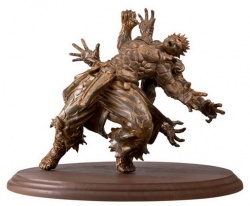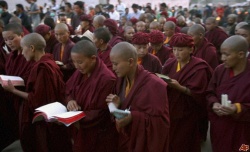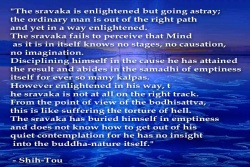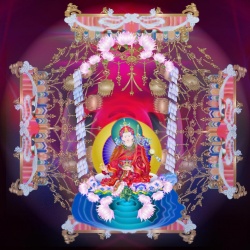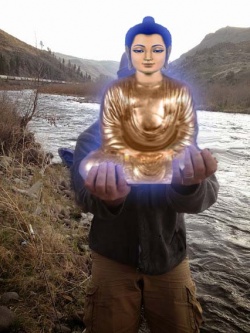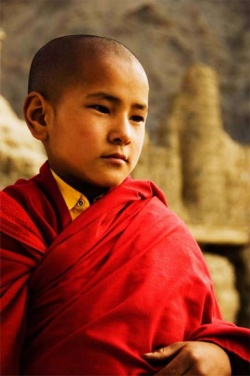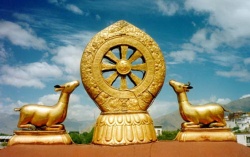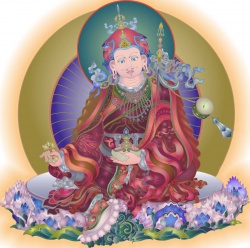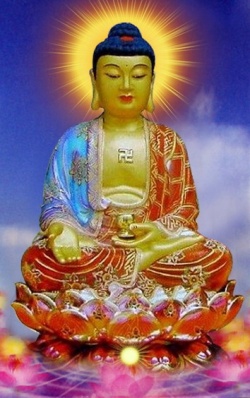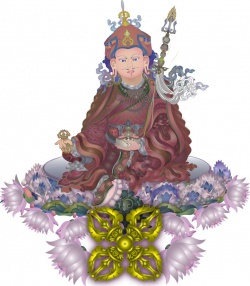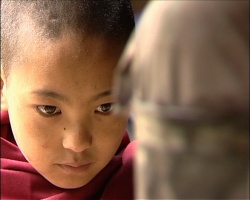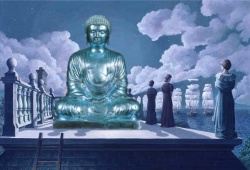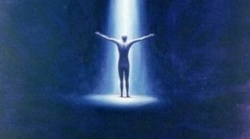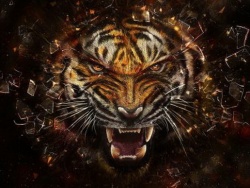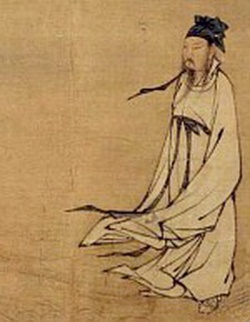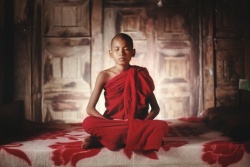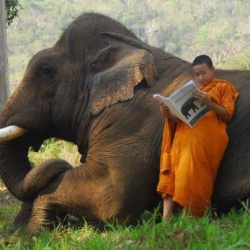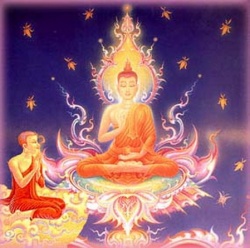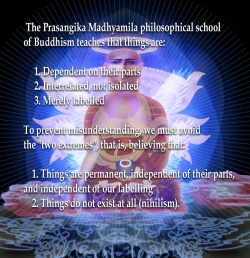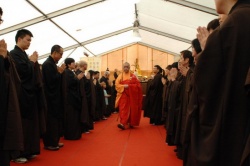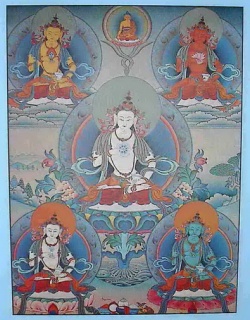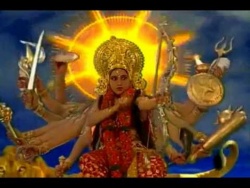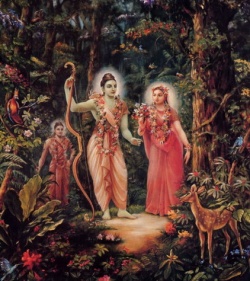Difference between revisions of "Spirit"
m (Text replacement - "[[[" to "([[") |
m (Text replacement - "]]]" to "]])") |
||
| Line 191: | Line 191: | ||
| − | The [[lotus]] is the [[representation]] of the [[physical world]], and the various classes of [[beings]] are described as living on or under or outside its petals. The 8 Classes of [[Spirits]] and Ogres found there, including [[yakshas]] [ Tib.: [[sadag]],] [[nagas]] [lu] and [[rakshasas]] ([[nyen]] | + | The [[lotus]] is the [[representation]] of the [[physical world]], and the various classes of [[beings]] are described as living on or under or outside its petals. The 8 Classes of [[Spirits]] and Ogres found there, including [[yakshas]] [ Tib.: [[sadag]],] [[nagas]] [lu] and [[rakshasas]] ([[nyen]]) vary only in details according to the different [[Tibetan Buddhist]] authorities. |
Latest revision as of 18:41, 4 April 2016
Click here to see other articles relating to word Spirit
The English word spirit (from Latin spiritus "breath") has many differing meanings and connotations, most of them relating to a non-corporeal substance contrasted with the material body.
The word spirit is often used metaphysically to refer to the consciousness or personality.
The notions of a person's spirit and soul often also overlap, as both contrast with body and both are understood as surviving the bodily death in religion and occultism, and "spirit" can also have the sense of "ghost", i.e. a manifestation of the spirit of a deceased person.
The term may also refer to any incorporeal or immaterial being, such as demons or deities, in [[Wikipedia:Christianity|Christianity]] specifically the Holy Spirit (though with a capital "S") experienced by the disciples at Pentecost.
Etymology
The English word spirit comes from the Latin spiritus, meaning "breath", but also "spirit, soul, courage, vigor", ultimately from a Proto-Indo-European *(s)peis. It is distinguished from Latin anima, "soul" (which nonetheless also derives from an Indo-European root meaning "to breathe", earliest form *h2enh1- ).
In Greek, this distinction exists between pneuma (πνευμα), "breath, motile air, spirit," and psykhē (ψυχη), "soul" (even though the latter term, ψῡχή = psykhē/psūkhē, is also from an Indo-European root meaning "to breathe":
- bhes-, zero grade *bhs- devoicing in proto-Greek to *phs-, resulting in historical-period Greek ps- in psūkhein, "to breathe", whence psūkhē, "spirit", "soul" ).
The word "spirit" came into Middle English via Old French.
The distinction between soul and spirit also developed in the Abrahamic religions: Arabic nafs (نفس) opposite rúħ (روح); Hebrew neshama (נְשָׁמָה nəšâmâh) or nephesh (in Hebrew neshama comes from the root NŠM or "breath") opposite ruach (רוּחַ rûaħ).
(Note, however, that in Semitic just as in Indo-European, this dichotomy has not always been as neat historically as it has come to be taken over a long period of development:
Both נֶ֫פֶשׁ (root נפשׁ) and רוּחַ (root רוח), as well as cognate words in various Semitic languages, including Arabic, also preserve meanings involving misc. air phenomena: "breath", "wind", and even "odour"
Metaphysical and metaphorical uses
English-speakers use the word "spirit" in two related contexts, one metaphysical and the other metaphorical.
Metaphysical contexts
In metaphysical terms, "spirit" has acquired a number of meanings:
An incorporeal but ubiquitous, non-quantifiable substance or energy present individually in all living things. Unlike the concept of souls (often regarded as eternal and sometimes believed to pre-exist the body) a spirit develops and grows as an integral aspect of a living being.
This concept of the individual spirit occurs commonly in animism. Note the distinction between this concept of spirit and that of the pre-existing or eternal soul: belief in souls occurs specifically and far less commonly, particularly in traditional societies.
One might more properly term this type/aspect of spirit "life" (bios in Greek) or "aether" rather than "spirit" (pneuma in Greek).
A daemon sprite, or especially a ghost. People usually conceive of a ghost as a wandering spirit from a being no longer living, having survived the death of the body yet maintaining at least vestiges of mind and of consciousness.
In religion and spirituality, the respiration of a human has for obvious reasons become seen as strongly linked with the very occurrence of life. A similar significance has become attached to human blood.
Spirit, in this sense, means the thing that separates a living body from a corpse—and usually implies intelligence, consciousness, and sentience.
Latter-day Saint prophet Joseph Smith Jr. taught that the concept of spirit as incorporeal or without substance was incorrect: "There is no such thing as immaterial matter. All spirit is matter, but it is more fine or pure, and can only be discerned by purer eyes."
In some Native American spiritual traditions the Great Spirit or Wakan Tanka is a term for the Supreme Being.
Various forms of animism, such as Japan's Shinto and African traditional religion, focus on invisible beings that represent or connect with plants, animals (sometimes called "Animal Fathers)",
or landforms (kami) : translators usually employ the English word "spirit" when trying to express the idea of such entities.
Individual spirits envisaged as interconnected with all other spirits and with "The Spirit" (singular and capitalized). This concept relates to theories of a unified spirituality, to universal consciousness and to some concepts of Deity.
In this scenario all separate "spirits", when connected, form a greater unity, the Spirit, which has an identity separate from its elements plus a consciousness and intellect greater than its elements;
an ultimate, unified, non-dual awareness or force of life combining or transcending all individual units of consciousness.
The experience of such a connection can become a primary basis for spiritual belief. The term spirit occurs in this sense in (to name but a few) Anthroposophy, Aurobindo,
A Course In Miracles, Hegel, Ken Wilber, and Meher Baba (though in his teachings, "spirits" are only apparently separate from each other and from "The Spirit.")
In this use, the term seems conceptually identical to Plotinus's "The One" and Friedrich Schelling's "Absolute". Similarly, according to the panentheistic/pantheistic view,
Spirit equates to essence that can manifest itself as mind/soul through any level in pantheistic hierarchy/holarchy, such as through a mind/soul of a single cell (with very primitive, elemental consciousness), or through a human or animal mind/soul (with consciousness on a level of organic synergy of an individual human/animal),
or through a (superior) mind/soul with synergetically extremely complex/sophisticated consciousness of whole galaxies involving all sub-levels, all emanating (since the superior mind/soul operates non-dimensionally, or trans-dimensionally) from the one Spirit.
Christian theology can use the term "Spirit" to describe God, or aspects of God — as in the "Holy Spirit", referring to a Triune God (Trinity)(cf Gospel of Matthew 28:19).
"Spirit" forms a central concept in pneumatology (note that pneumatology studies "pneuma" (Greek for "spirit") not "psyche" (Greek for "soul") — as studied in psychology).
Christian Science uses "Spirit" as one of the seven synonyms for God, as in: "Principle; Mind; Soul; Spirit; Life; Truth; Love"
Harmonism reserves the term "spirit" for those that collectively control and influence an individual from the realm of the mind.
Metaphorical usage
The metaphorical use of the term likewise groups several related meanings:
The loyalty and feeling of inclusion in the social history or collective essence of an institution or group, such as in school spirit or esprit de corps.
A closely related meaning refers to the worldview of a person, place, or time, as in "The Declaration of Independence was written in the spirit of John Locke and his notions of liberty", or the term zeitgeist, meaning "spirit of the age".
As a synonym for "vivacity" as in "She performed the piece with spirit" or "She put up a spirited defense".
The underlying intention of a text as distinguished from its literal meaning, especially in law; see Letter and spirit of the law
As a term for alcoholic beverages.
In mysticism: existence in unity with Godhead. Soul may also equate with spirit, but the soul involves certain individual human consciousness, while spirit comes from beyond that. Compare the psychological teaching of Al-Ghazali.
Related concepts in other languages
Similar concepts in other languages include Greek pneuma and Sanskrit akasha/atman (see also prana).
Some languages use a word for "spirit" often closely related (if not synonymous) to "mind".
Examples include the German Geist (related to the English word "ghost") or the French 'l'esprit'. English versions of the Bible most commonly translate the Hebrew word "ruach" (רוח; "wind") as "the spirit", whose essence is divine (see Holy Spirit and ruach hakodesh).
Alternatively, Hebrew texts commonly use the word nephesh. Kabbalists regard nephesh as one of the five parts of the Jewish soul, where nephesh (animal) refers to the physical being and its animal instincts.
Similarly, Scandinavian languages, Baltic languages, Slavic languages and the Chinese language (qi) use the words for "breath" to express concepts similar to "the spirit"
Higher Realms
The uppermost realm on the Wheel of Rebirth is that of the devata. There are four highest devas or gods of which two, Indra and Brahma, appear most often in Buddhist scriptures where Indra, ruler of the upper realm, is called Shakra (Pali: Sakka.) In the orthodox Indian view, Brahma is the Intelligence that can be compared to the deity of the western religions, but he does not have that role in Buddhism. Shiva (in Tibetan, Lha Chen) also plays an important role; in fact his god-realm is called Shambhala.
In the Buddhist view, these gods and goddesses are, for the most part, considered to be highly evolved bodhisattvas.
The gods are waited upon by apsaras -- beautiful attendants and messengers, and gandharvas -- heavenly dancers and musicians. (The dakini can be included in both these categories.)
Indian mythology makes some distinction between rakshasas -- titans or the anti-gods -- and yakshas that are nature spirits, often tricksters. The former seek to usurp the powers of the gods or devas but the word rakshasa is also often translated ogre (Skt. ugra) or demon. Sometimes there seems to be no clear distinction between the two categories, and there are considered to be various types of both.
Tibetan tradition, Buddhist or not, has a large variety of these kinds of beings. A distinction is made between the deities and the local or worldly spirits. The former are objects of Refuge, while the latter may be considered as protectors but not usually sources of Refuge. Often they are propitiated in return for services rendered. In Buddhism, this custom stems from:
". . . the ninth century when the Tibetan king, Trisong Deutsen, invited Shantarakshita from India to teach Buddhism in Tibet. The local spirits proved hostile to this foreign religion and actively obstructed the efforts of the Indian spiritual master. Shantarakshita then advised the Tibetan king to invite Guru Padmasambhava, a tantric adept from India, to deal with these hostile spirits. Accordingly, Padmasambhava (also known as Guru Rinpoche) came to Tibet and subdued the most powerful spirits. Once vanquished, the spirits were bound by oath to act as Dharma Protectors. Thus, worldly protectors began to play a role in the Tibetan Buddhist pantheon.
One day, before the king and his ministers, Padmasambhava summoned one of the Four Great Kings, (the protectors of the four directions often depicted around the doors of Tibetan temples) into the body of a young man. Using the youth's body as a medium, the clairvoyant deity identified the spirits who were creating trouble. The deity pronounced that the spirit Thangla was responsible for the lightning strike on Marpori (the Red Hill that became the site of the Potala Palace) and that the spirit Yarla Shampo had provoked the flood which washed away the Phangthang Palace. This was the first occasion in Tibet in which a worldly deity was summoned into the body of a human being, . . . ." ~
Regarded in Buddhism as 8 types of impure manifestation of consciousness, they are:
hla [or lha] devas
ging attendants, musicians and dancers
sadag [genii, titans or guardians of 'upper' realms ],
Maras: creators of obstacles,
Klesha who embodies passion,
Yama who is death,
Skandha who is war,
Rahula Ganapati, the Godly Son," who is adversity or obstacle
tsen earth-spirits
nyen or rakshasa elementals, demons
mamo ogres
lu or nagas
Demons
"In other traditions demons are expelled externally. But in my tradition demons are accepted with compassion." ~ Machik Labdron, patron of the Chod practice.
Very Ven. Khenpo Karthar, abbott of Karma Triyana Dharmachakra, Woodstock, NY:
" There is not any event that under all circumstances is an obstacle. During your life, sometimes a test situation may arise because of your meditation. If
you lack understanding and meditative insight, this test could become an obstacle. However if you have enough insight and understanding, the test could heighten your realization to a great extent. As an outcome of meditative experience, whatever appearances may arise can be transformed through meditative insight into a realization of the nature of all things as insubstantial, uncompounded, and only existing interdependently. Then we do not reject the appearances of existing things, but nevertheless none of these things hold the truth of independence or the truth of substantiality. They are just another play of illusion.
If a person understands and relates in this way, whatever drama appears in meditation could be tremendously uplifting. On the other hand, when you are meditating you may get drawn into whatever arises out of your habitual and emotional conditioning. The appearance may just be your psychological patterns, but for you it is a spirit, it is demonic, and it is real. You will probably be afraid and try to defend yourself. That is not the strategy we adopt in the path of meditation, though.
For instance, when Milarepa was in a particular cave and the so called demons appeared, roaring and thundering toward him, Milarepa said, "Your appearance is most wondrous, and your message is the message of my teacher." He worked with it in that way. The demon of your confusion does not cling to you; you cling to it. From that point of view, such an event becomes a kind of special treat and a technique that brings more enrichment than the ordinary process. What is really important is how a person is able to work with what happens, so strictly speaking, these neither are obstacles or are not obstacles." ~ KTD web site
Kinds of Unseen Beings
The lotus is the representation of the physical world, and the various classes of beings are described as living on or under or outside its petals. The 8 Classes of Spirits and Ogres found there, including yakshas [ Tib.: sadag,] nagas [lu] and rakshasas (nyen) vary only in details according to the different Tibetan Buddhist authorities.
According to the Longdo lama Nyawang Losang's Enumeration of the Names of Oath-bound Guardian Beings (Beyer 294) there are the
1. lha who are white,
2. deu who are black,
3. tsen who are red,
4. za who are multi-coloured,
5. mu who are brown,
6. sinpo who are flesh-eaters,
7. jepo, treasure protectors and
8. mamo who bring disease.
According to the Five Precepts of Padmasambhava, we have another list:
1. gongpo
2. teurang,
3. ngayam
4. sadag
5. yulha
6. men
7. tsen
8. lhu.
A different list consists of:
1. sogdag
2. mamo
3. shinje
4. deu
5. neujin
6. mu
7. dralha
8. gongpo.
Beyer found a Tara Sadhana of Anupama.rakshita's that asks protection from "evil spirits above, planets and constellations, evil spirits below, and the sadag, lu and nyen, and harm from evil spirits upon the surface of the earth, the ghosts, kings and tsen."
In fact, there is not much contradiction here for in the main, the Tibetan classification follows the traditional Indian one.
Read some lyrics of the Tibetan Gesar of Ling epic in which goddess Ma Nene Karmo describes the unseen realms.
Take a demon as a demon and it will harm you.
Know a demon is in your mind and you'll be free of it.
Drala or Dralha?
Drala is actually a transliteration for two different Tibetan terms. Therefore it stands for two slightly different kinds of deity. One is spelled sgra bla, and the other is spelled in Tibetan, dgra lha. The first one with the element, sgra refers to a kind of energy; it is a vibrational entity. The second (dgra-) word ends in the syllable lha, and it is a kind of god.
Drala spelt sGra bla begins with the syllable sgra which means sound, and continues with la that here means "a type of individual energy that is endowed with protective functions" (Norbu 1995.) For example, seng- ge'i sgra means the lion's roar. It is also possible to write and hence, refer to sgra'i lha since sGra means a sound or cry, but using lha here instead of la conveys the meaning of a sound deity.
The Tibetan term lHa standing alone means god or deity -- usually it refers to one of the devata, a being of the highest realm in the context of The Wheel of Existence. [The syllable LHA found in transliterated Tibetan is pronounced HA.]
The Vibe
We have seen that drala spelled sGra-la (no "h" sound) refers to a spirit of sound, and it is based on ancient ideas about the unseen world and its influences. Sound is an aspect of our nature that has a kind of dual existence. Although it is invisible, it is generally perceived by our common sense of hearing, but according to Namkhai Norbu (Drung, Deu, and Bèon 1995) it is also linked to the individual's positive force or Cha (cf, Qi or Chi of transliterated Chinese) which is also the base of prosperity, and to the wang-thang (ascendancy-capacity. [bio-rhythm?] Both of these aspects are seen as related to the protective deities and entities from the moment of a person's birth. Sound is considered the foremost connection between the individual and his la [lha?.] This is the meaning of the word sgra-la."
Trungpa Rinpoche (and some other lamas) refer to a drala principle and also, to the benefits of working at being open to meeting the dralas. There, the dralas are elements of reality, something like European fairies, since we can know them only when we are open in our perception and attuned to our surroundings.
Guardian Angels
The Biblical patriarch Jacob became known as Israel after struggling with an angel who wounded him "in the thigh." In that context, the Hebrew word for "angel" also denotes a kind of adversary.
In the Tibetan context there is a similar idea, since the word dGra means adversary, opponent, or champion (in the sense of combat.) The lha at the end of the word beginning with dGra is used for ancestral spirits. It also turns up in the context of the Tibetan epic, Gesar of Ling, where according to Nebesky1956,318) the hero was called " dgra lha of Zhang Zhung."
However, Karmay (1975, 218) a translator of several traditional Tibetan texts, found a reference to dgra-bla, a blending of the two prevailing concepts, in the work of Jamgong Kongtrul the Great. Mipham also used that third word in " the drala (dgra bla) who extended the power of Shang Shung" (Norbu 1995, 58)
In the first of the two forms, the word can also refer to one's personal guardian spirit, a " Divine principle that protect against attack or enemies," (Nalanda Translation Committee 1997.) Therefore, if for some reason, this kind of drala is weakened or ceases to function, it can act as a sort of spiritual nemesis or saboteur, an " enemy who prevents man from being potent" (Paul 1982.)
The dGra word ending in lha gives the meaning, "above the enemy" or "beyond aggression." (The personal name dgra dul or as we usually see it in Romanised format, Dodul, meaning one who vanquishes opponents.)
Dralha spelled dGra-lha can also refer to a true war deity such as Zhang-Zhung Gi Dgra-Lha who is the war goddess of Shang-shung.
In Tibetan culture which is not entirely monolithic or homogenous, but varies according to the region and the religious view of a family or a population, there are numerous lha of many different kinds.
Phug-lha are Tibetan domestic deities that protect all family members and their goods.
Accordingto Namkhai Norbu (1995, 251) they govern the cha and yang of the home and defend them against damage. " They may be disturbed if a tantric Buddhist or Bon practitioner comes into the kitchen, as their protective deities usually belong to the class of rGyal po or bTsan, which can easily conflict with the Phug lha. Then it is necessary to perform a bSang rite to restore harmony."
The "Offering to the Five Deities of the Individual" by the Fifth Dalai Lama (1617-1682) discusses the deities that reside with a person. They are called the "gowe lha" and are believed to take birth at the same time as a child. They comprise:
a Dralha, the personal protector or "enemy" god that resides on the right shoulder.
a Soglha or life deity, whose seat is in the heart.
a Molha or female god, in the left armpit
a Pholha or male lineage god, in the right armpit.
There is also a Yul-lha, the local god, whose position is at the crown of the head. (Samuel 1993, 187)
Anne-Marie Blondeau says that normally [in the case of patrilocal households?] or/and as long as there is only one clan living in an area, the Pho Lha and the Yul Lha are indistinguishable. Interestingly, it seems that in the case of some Tibetans who emigrated to the Mont Blanc region of Switzerland, the yul-lha followed them to their new home (1996, x.)
Oracles and Mediums
If "the lha is about to enter the subject's body and wants to communicate through this vessel. The body is the medium for the deity. In order for the lha to settle in the human body, the mind of the subject must be completely void. Once in the lha-state, the human becomes a lha, the deity himself. Since modern Western culture does not believe in spirits and deities, this bodily expression of a spiritual manifestation is regarded as a 'psycho-physical transformation of consciousness' (Schenk in Brauen, M. ed. Proceedings of the International Seminar on the Anthropology of Tibet and the Himalaya : Sept. 21-28, 1990. Ethnographic Museum of U. of Zurich, 1993.)
~ The Dralha segment is from Okar's Review website, no longer online.
Chogyam Trungpa Rinpoche once told Jeremy Haward that "although there was great development of wealth in the Western world, through a lot of manufacturing, mining of the earth and so forth, much of the vitality of the land had been harmed, and because of that the dralas had departed."
One person's god is another's devil.
In ancient Iranian mythology, the term deva or daeva is understood to refer to a demon. That is how English acquired the word devil. And the word ashura that signifies, in India, an opponent to the gods or Hindu devas, derives from the Iranian word Ahura (the s was dropped as a result of one of the characteristic transformations in the migration of vocabulary) that signifies the benevolent one of a pair of deities.
Tulpa
A tulpa is what is called in Yiddish a golem. It is a manifestation created by an adept to accomplish a certain task or tasks.
"Once the tulpa is endowed with enough vitality to be capable of playing the part of a real being, it tends to free itself from its maker's control . . . . Tibetan magicians also relate cases in which the tulpa is sent to fulfill a mission, but does not come back and pursues its peregrinations as a half-conscious, dangerously mischievous puppet. The same thing, it is said, may happen when the maker of the tulpa dies before having dissolved it."
~ Alexandra David-Neel, With Mystics and Magicians in Tibet.
Rolang
A rolang is like a zombie. This is a human being whose body is alive but who is neurologically and psychologically paralyzed to the degree that he or she functions like an automaton.
"Wade Davis wrote a book (The Serpent and the Rainbow, 1985) in which he tried to demonstrate that Haitian zombies are people who have been poisoned first with puffer fish poison and then later with datura. They are then kept in a brain-damaged state and sometimes used as laborers. To be zombified is said to be a "fate worse than death" reserved for those who have offended community norms.
I know that Haitian culture is far from Tibet, however, datura does grow
in the Himalayan regions and is one of the symbols of and traditional
offerings to Mahakala (Dorje Gonpo). If I remember correctly, the ancient Scythians in central Asia inhaled datura fumes in a ritual context. Perhaps Tibetan rolang are people who have been brain damaged by deliberate or accidental datura poisoning who revive after being in a coma. [So] Believing in zombies may not be so irrational after all. [And] It would make killing them a non-meritorious act.
A friend of mine who was in Tibet two years ago said that people he knew took the existence of rolang for granted and said that the high wooden thresholds of Tibetan houses were to keep them out as they cannot bend their knees. "
